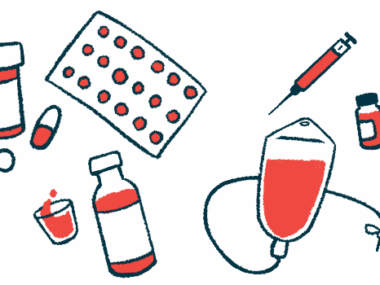‘Changing My Major (Organs)’: A Chronicle of Bilateral Lung Transplant
Written by |

I was evaluated for my bilateral lung transplant in March 2019. I was transplanted on June 14, 2019, and graduated from physical therapy two months after that. Although transplant facts are more accessible today than in the past, many patients remain in the dark, so I’ll tell you about my experience.
Before surgery
There are three reasons why a cystic fibrosis patient might qualify for a transplant. The first is when they’re in end-stage disease and require life-saving surgery. They second is when they’re resistant to antibiotics. And the third is when they have no quality of life. I qualified based on all three criteria.
Some of my symptoms included increased carbon dioxide and an increased need for oxygen. I felt so fatigued and atrophied that I required a bathroom buddy. I dehydrated easily and couldn’t maintain my weight, and my bloodwork resided in the at-risk range.
Despite obvious symptoms, the timing was complicated. A transplant must be performed when the patient is sick enough to qualify for surgery, but well enough to make it through the surgery. There’s no true “sweet spot,” just an educated guess.
I was also told my donor lungs would come with an expiration date. As a result, I was encouraged to live with my birth lungs for as long as possible.
“Good lungs can last anywhere from eight to 10 years,” a nurse said during my evaluation. The number seemed incorrect, considering one of my friends passed within a year of her surgery, while another was celebrating her 16th “lung-versary.”
Moreover, due to a lack of organ availability, some patients pass before receiving new organs. My donor lungs had to be a perfect match, so factors like the extent of the match, my donor’s health, and post-surgery compliance would affect my outcome, too.
I underwent dozens of tests over a three-day period during my evaluation, ranging from barium swallow tests to echocardiograms.
My team presented the test results to the hospital’s transplant board, which decides if patients qualify for transplant, and if so, provides the patient with a lung allocation score (LAS). The higher the LAS, the higher a person’s position is on the list. Of course, it still comes down to whether a match is available.
Once I was listed, I answered every unknown caller on my phone, knowing that one of them was a call for lungs. A nurse explained that the caller moves on to the next candidate if the patient and all their emergency contacts screen the call. Needless to say, we never missed a call, and I was one of the lucky patients who was transplanted almost immediately.
During
I was asleep during my transplant, so I’ll leave the details to the scientists. I do, however, remember three things: First, I was placed on ECMO, which stands for extracorporeal membrane oxygenation, a form of life support, which resided between my thigh and my groin during transplant. Second, my scars were strategically placed under my breasts. Third, before anesthesia kicked in, I told myself, “You’ll be in pain when you wake up, but at least you’ll be able to breathe.”
After
When I woke up in the ICU, I couldn’t breathe. Six IV’s, six chest drains, and a trach obstructed my view, among other wires. I couldn’t eat or drink. All of my medications were exchanged for new ones, and they were rapidly pumped into my veins.
Staff got me up and walking within a few days of my surgery. The phrase “the faster you use your lungs, the longer they’ll last” played like a broken record. I had several bronchoscopies to check for rejection, most without anesthesia. My tolerance grew slim, but my lungs grew strong.
I was moved to the transplant wing a few days after that and discharged to the Gift of Life Family House a few weeks after that.
“You may not drink tap water or anything from a fountain. Avoid steam rooms and hot tubs. Do not swim in suspicious water, touch birds, or hike above a certain height …”
The list of rules went on.
“Changing My Major,” from the Broadway musical “Fun Home,” is my go-to audition piece. A teenager expresses a mixture of emotions after her first lesbian romance, including the fear associated with a new lifestyle. I felt similarly after my transplant. I was grateful for my donor’s lungs, but I also felt like a witness protection victim, adjusting to a new body and a new life.
Transplantation is terrifying. It requires emotional and physical strength, resilience, and hope — but it’s worth the effort. I’m thankful that you’re reading this column and not my obituary. In the scheme of things, what’s a major organ change between strangers?

From left, Nicole’s mom, Patty, husband, Jared, and aunt Helene accompany her in the hospital ahead of a bilateral lung transplant at the Hospital of the University of Pennsylvania on June 14, 2019. (Photo by Nicole Kohr)
Check back every Thursday to hear more of my story.
***
Note: Cystic Fibrosis News Today is strictly a news and information website about the disease. It does not provide medical advice, diagnosis, or treatment. This content is not intended to be a substitute for professional medical advice, diagnosis, or treatment. Always seek the advice of your physician or other qualified health provider with any questions you may have regarding a medical condition. Never disregard professional medical advice or delay in seeking it because of something you have read on this website. The opinions expressed in this column are not those of Cystic Fibrosis News Today, or its parent company, Bionews, and are intended to spark discussion about issues pertaining to cystic fibrosis.








Leave a comment
Fill in the required fields to post. Your email address will not be published.